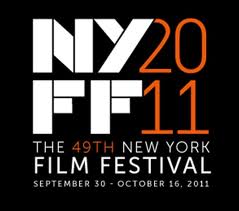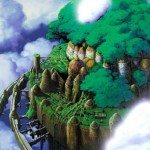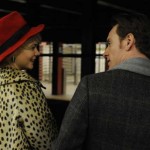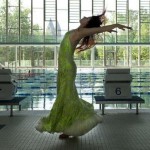NY Film Festival 2011
Saturday October 8
25th Anniversary of Hayao Miyazaki’s Castle in the Sky
Having seen his later works first, most notably Princess Mononoke and Howl’s Moving Castle, I see how the same themes have been percolating in Miyazaki for quite some time. The idea of nature over automation as well as that of a floating castle are both present in this 1986 gem. There is also a parallel with Sheeta and the female protagonist in Howl, Sophie, as both have long braids which are significantly removed at the end. This coupled with a NY Indian summer was a wonderful start to my week at NYFF.
The new Lincoln Center is in place, with an extra film theatre as well as a café with a grass roof upon which people may laze while watching the scene below or across at Avery Fisher Hall or Juilliard. Interesting idea, the grass roof; don’t know how it will be over winter with the snow . . .
Sunday October 9
Steve McQueen’s Shame
Michael Fassbender is paired for a second time with British director Steve McQueen. Set in current-day NYC, it is a rather cold look at nymphomania, as Brandon’s fastidiousness in his daily life is juxtaposed with his uncontrollable sexual needs. His secret double life begins to fray at the seams when his younger sister Sissy, played by Carey Mulligan, moves in. While Brandon is emotionally unavailable, Sissy feels too much. Towards the climax when Brandon has to face his problem or lose his sister, the distortion of his reflection in a glass was really effective in showing his emotional unraveling.
Béla Tarr’s Turin Horse
Shot in black and white, play with light and shadow against the powerful sound of the windstorm immediately set the tone of the film, while the mise-en-scène sets the languorous pace. For the last film of his career, Béla Tarr chose to meditate on the incident in Turin of a driver beating his horse that made Nietzsche throw his arms around the horse weeping and collapse, spending the next and final 10 years of his life almost in total silence. The story here is about the driver and his family and what happens within the course of 6 days during an intense windstorm. The driver lives with his daughter and the two make out a subsistent life on the unforgiving Hungarian plains.
After the screening, when asked why this was his last film, Tarr answered that he wanted to make something essential for his last piece, something that touched upon the pure and true, and that his job was done.
At 146 minutes, the film is certainly not over-edited, possessing a raw quality to it, and clearly following a different set of rules than what the American film industry generally follows. Bleak yet not despairing, Tarr’s commentary on life is at once lyrical and reverent, where upon life’s end one just fades quietly away, without pomp or circumstance.
Monday October 10
Martin Scorsese’s Hugo
Still a work in progress. The director himself came out to list the work that still needed to be done, including color correction, final vfx, credits, 3D fx, and music.
The unfinished 3D gave me a tremendous headache, and I still don’t know if it really added anything to the film. The opening scenes were still in previsualization mode, blocking out the general layout of stuff and people, and there were building models that were not yet textured. It was nice to see that we are proceeding as any film would, with previsualizations and all, and that there is relevance to what we are doing, as clearly the great films of old are continuing to inspire filmmakers of the current age.
An added bonus was a nod to Caligari, when the kids are flipping through a history of film book and among the photos is the close up of the Somnambulist.
Wednesday October 12
Pedro Almodóvar’s The Skin I Live In
An exploration into mad science, Almodóvar’s latest takes one down yet another winding path into his somewhat twisted imagination. It was a star-studded evening, with Almodóvar himself, Antonio Banderas, and the rest of the starring cast to introduce the movie. A revelation was the lead actress, Elena Anaya, who was both stunning in her acting as well as her appearance.
The science-fiction element of the complete trans-gender transformation where sections of the victim Vera’s body has been trans-genetically grafted (whatever that means), reminded me of our Somnambulist, especially when she wears the bodysuit to help keep the skin together, as if through the transformation, Vera’s not quite human anymore, as a part of her former self will be forever lost, both literally & figuratively.
Ulrich Köhler’s Sleeping Sickness
If this film was meant to be a meditation on the state of Africa, it did not shed any new light on the matter. What the director was going for here remained unclear till the end, and the film lacked direction and a story arc. The pacing did inform on how to set a certain tone, which will be key in The Somnambulist.
Thursday October 13
George Méliès’ A Trip to the Moon 1902
With my week opening with Scorsese’s Hugo in homage to Méliès, to see the actual La Voyage dans la Lune only seemed fitting. Restored with color, La Voyage is full of the exuberance of the age, the hopeful dawn of the 20th century. Méliès’ raw excitement in the new technology of cinema is apparent, and the whimsical sets, costumes, and special effects reflect the director’s boundless creativity and imagination. It is amazing that this joy in filmmaking is still clearly conveyed to audiences more than 100 years later; while the actors themselves are long gone, their personalities are still immediately accessible through the amazing medium of film. At some human level the spectator and player connect through the time warp of cinema, revealing an essence that remains constant and thus the magical nature of the art form.
The new soundtrack by Air was a bit jarring, a clash of styles, which was too bad, but all in all the experience was thoroughly enjoyable.
Karl Heinz Martin’s From Morning till Midnight 1922
Twenty years after A Trip to the Moon, Europe was smarting from WWI, and German Expressionism explored the darker notes in film. German Expressionists set their worlds askew, the rosy hues of the century’s beginning replaced by sharp angles and a preoccupation with death and mortality. While Caligari is an iconic example of this movement, From Morning till Midnight pushed the envelope even further and was deemed too radical to be released in Germany, though hailed as a grand achievement in Japan. Highly stylized, the sets and acting do not make any attempt at reality; the film is a dance in metaphor and symbolism. Desperation for money leading to an eventual suicide, Martin painted a bleak picture, which was probably not too far from the truth.
An added bonus was Alloy Orchestra’s live accompaniment to the film, providing a fitting soundscape that really added to the experience.
This is the film that brought me to the NY Film Festival, and thinking about how it informs our work on The Somnambulist, I realize we are focusing more on a personal story rather than on archetypal issues of the current human condition. At five minutes, our principal goal is to clearly convey a story; however we should still keep in mind that part of the genius of Caligari is how it was both a personal story as well as a commentary on the state of Germany, and while From Morning might have taken the symbolism to an extreme point, its message in the end was clear: Ecce Homo. Can The Somnambulist be a short reflection of our current age in five minutes? Wait and see . . .
Friday October 14
Michel Hazanavicius’ The Artist
As this week’s choice of films have for the most part been a looking back at the art of cinema, The Artist pays loving homage to late-1920’s Hollywood, when silent films were being replaced by “talkies”. Shot in black and white, French director Hazanavicius chose a French and American cast for his modern silent. All the conventions of 1920’s Hollywood are used against the backdrop of the playful soundtrack so that even when the tone changes towards the serious, there is still an air of expectation that any moment the scene will suddenly break into a song or dance. Lead actor Jean Dujardin plays his Douglas Fairbanks-type character to perfection and Bérénice Bejo is a wonderful ingénue, both capturing the quintessential feeling of old-Hollywood celebrity.
Without the use of special effects besides the wonderful effect of sound used at choice moments, Hazanavicius is able to convey the initial magic of the new medium. Cinema began as a record of real life, but with its vast storytelling capacities, it soon became an escape into another reality, an alternate universe where people could temporarily forget their daily woes.
So while the German Expressionists explored the darker emotions of the human psyche, Hollywood was more about lifting spirits out of the gloom of war and financial crisis; indeed The Artist lifted the spirit of the audience to a standing ovation at the end.
Saturday October 15
Ruben Östlund’s Play
Swedish director Östlund plays with the notion of racial stereotypes through the eyes of 12 year olds in his latest film. Using long takes and wide shots, Östlund aimed to place the audience as distant spectators of the action, “first-class passengers” as the director himself put it, who could observe the events taking place as in a petri dish and possibly gain new conclusions from them.
Shot on the Red 4K camera, the film’s colors and detail were almost too crisp.
Like in Turin Horse, the long takes and fixed camera positions created a contemplative tone and feel to the film, giving the breathing space for events to transpire instead of forcing a point of view through more cuts and edits. These techniques could definitely be explored in The Somnambulist.
Oliver Stone’s Salvador 1986
Based on a book about the political turmoil in El Salvador during the early 1980’s, Oliver Stone shows his unique gift of storytelling early in his career. Made the same year as Platoon, Salvador conveys the chaos and senseless killings with a masterful stroke, using colors and music to much dramatic effect. In contrast to Play, Salvador feels real and immediate, as if one is thrown into the situation with the characters. There is no distance between the audience and the events transpiring onscreen, and James Woods’ portrayal of journalist Richard Boyle is the perfect blend of a flawed but ultimately good person with whom one can easily empathize.
Through shots, editing, and music, a movie can guide the audience to feel different emotions, which is a powerful thing – even in its 5 minutes, The Somnambulist should still aim to summon an emotional response from its audience.
Wim Wenders’ Pina
A tribute to the late choreographer Pina Bausch, Wenders’ latest is a beautiful showcase of dance as well as Pina’s legacy to her Tanztheater Wuppertal. Here Wenders uses 3D technology as a necessary tool for the film, successfully allowing the audience to be part of the dance process. Dance is usually quite flat on video, its emotional impact thus compromised; in this case, the 3D re-creates the visceral feel of a live performance and thus was an essential part of the entire experience.
Shot before James Cameron’s Avatar, Wenders came up against many of the same issues with 3D, namely that it did not capture movement very well. A test run of someone waving his arms showed the person with 4 arms. With much tinkering of the system however, Wenders was able to take full advantage of 3D technology.
With Pina, Wenders clearly shows how technology can truly enhance cinematic storytelling, thus validating one of our goals for The Somnambulist.
In Conclusion
This week at the NY Film Festival has been encouraging, informative, and inspiring in regards to SuD’s project as well as to filmmaking in general. It has made me see The Somnambulist in a different light – not just as a school project but how it connects with current trends as well as to the long legacy of filmmaking. Also, the wonderful myriad of movies from so many different points of view I have seen this week has re-ignited my enthusiasm to plunge into the industry, re-affirming my love for the art of cinema.
– Sherry Chow












